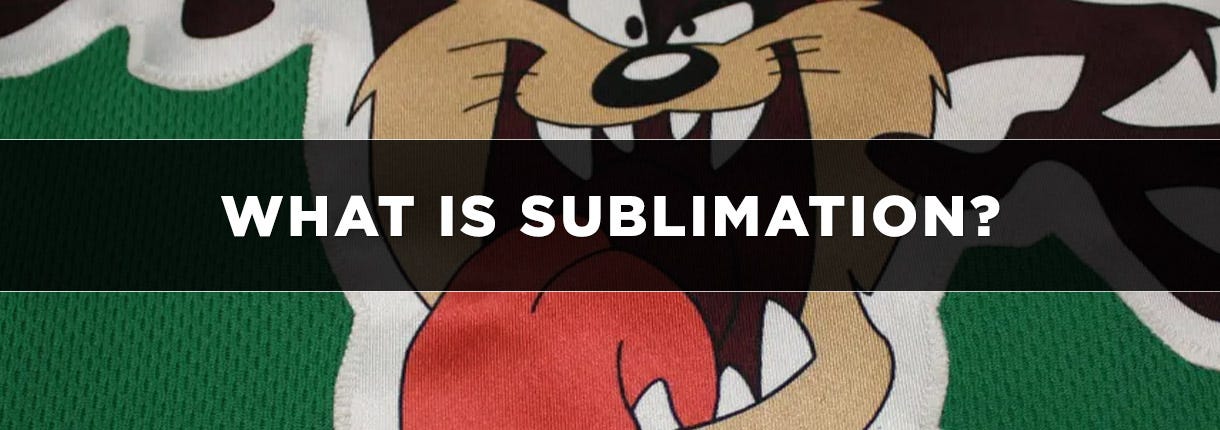What is Sublimation Printing in Hockey?

Sublimation printing has revolutionized the way jerseys and sports apparel are decorated. This innovative technique allows for vibrant, long-lasting designs that become part of the fabric itself. In the fast-paced world of hockey, where jerseys are a canvas for team spirit and individual flair, sublimation printing has become the gold standard for creating high-quality, durable jerseys.
Defining Sublimation Printing
Sublimation printing is a unique process that uses heat and pressure to transfer a design from a special paper directly onto fabric. Unlike traditional printing methods that lay ink on top of the fabric, sublimation printing dyes the fibers themselves. This creates a permanent, full-coverage design that won't crack, peel, or fade over time. Sublimation is most commonly used for polyester fabrics, making it ideal for creating athletic wear like hockey jerseys.
How Sublimation Printing Works
The magic of sublimation printing lies in the science behind it:
- Solid to Gas: Sublimation ink transforms from a solid state on the transfer paper to a gas state when exposed to high heat.
- Dyeing the Fabric: The gaseous ink then penetrates the open pores of the polyester fabric.
- Cooling and Bonding: As the press cools, the ink transforms back into a solid state, permanently bonding with the fabric fibers.
This process results in a design that is deeply embedded within the fabric, becoming part of the material itself. That's why sublimated designs are so durable and resistant to wear and tear.
The Sublimation Printing Process
Creating a sublimated hockey jersey involves several key steps:
- Design Creation: The design for the jersey is created digitally, incorporating logos, player names, numbers, and any other desired elements.
- Printing the Design: The design is then mirrored and printed onto special sublimation paper with specialized inks.
- Heat Transfer: The printed paper is placed on the fabric and secured. A heat press then applies high heat and pressure for a set amount of time.
- Sublimation: During this stage, the ink transforms and dyes the fabric fibers.
- Cooling and Finishing: Once the press cools, the transfer paper is removed, revealing the vibrant, permanently printed design on the jersey.
Sublimation in Hockey Jerseys
Sublimation printing offers numerous benefits for hockey jerseys:
- Durability: Sublimated designs withstand washing, sweat, and the wear and tear of the game, making them ideal for activewear.
- Vibrant Colors: Sublimation allows for sharp, detailed designs with a wide range of colors, perfect for showcasing team logos and player names.
- Breathable Fabric: Sublimation printing doesn't affect the breathability of the fabric, ensuring athletes stay cool and comfortable on the ice.
- Lightweight Feel: The design becomes part of the fabric, resulting in a lighter and more comfortable feel compared to traditional printing methods.
FAQs on Hockey Jersey Sublimation
What materials can and cannot be sublimated?
- Polyester fabrics work best for sublimation printing. Natural fabrics like cotton don't have the necessary open pores for the ink to adhere.
How durable are sublimated prints on apparel?
- Sublimated designs are highly durable and can withstand washing and wear for extended periods.
What are the environmental impacts of sublimation printing?
- While sublimation offers advantages, the printing process and inks can have some environmental impact. However, advancements are being made to create more eco-friendly sublimation techniques.
Can sublimation be used on dark fabrics?
- Sublimation typically works best on light-colored fabrics. However, special sublimation techniques can be used for dark fabrics with varying degrees of success.
How cost-effective is sublimation printing compared to other methods?
- Sublimation costs can be lower for larger orders as the setup process is minimal. For smaller batches, other methods like screen printing might be more cost-effective.
What are the limitations of sublimation printing?
- Sublimation works best with solid colors and simple designs. Creating photorealistic images or intricate details can be challenging.
![]()









Login and Registration Form
or
Create an account